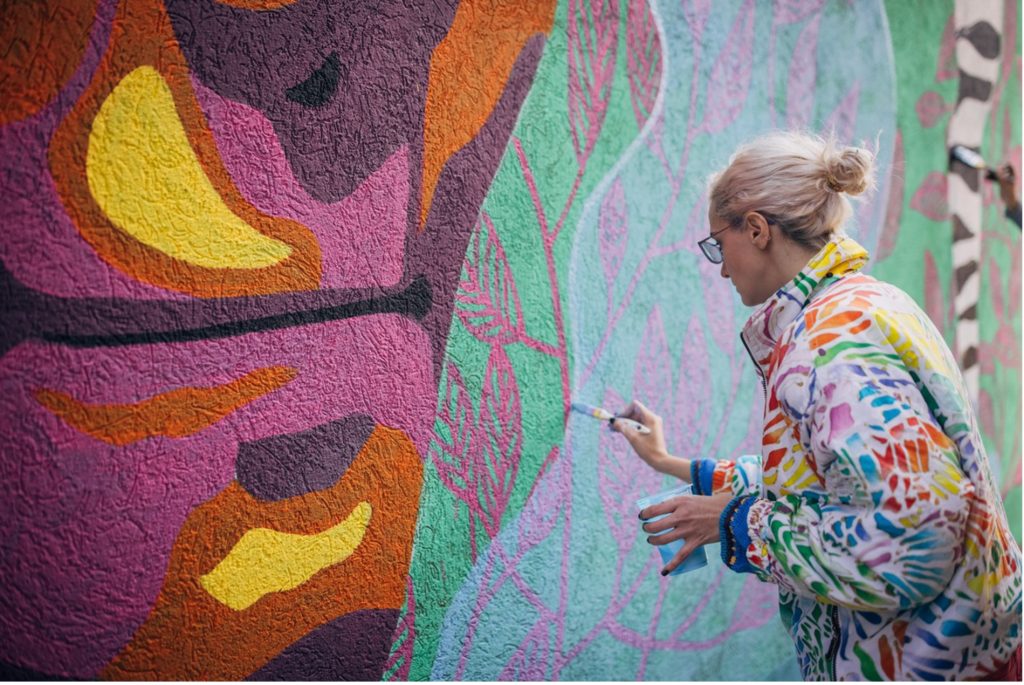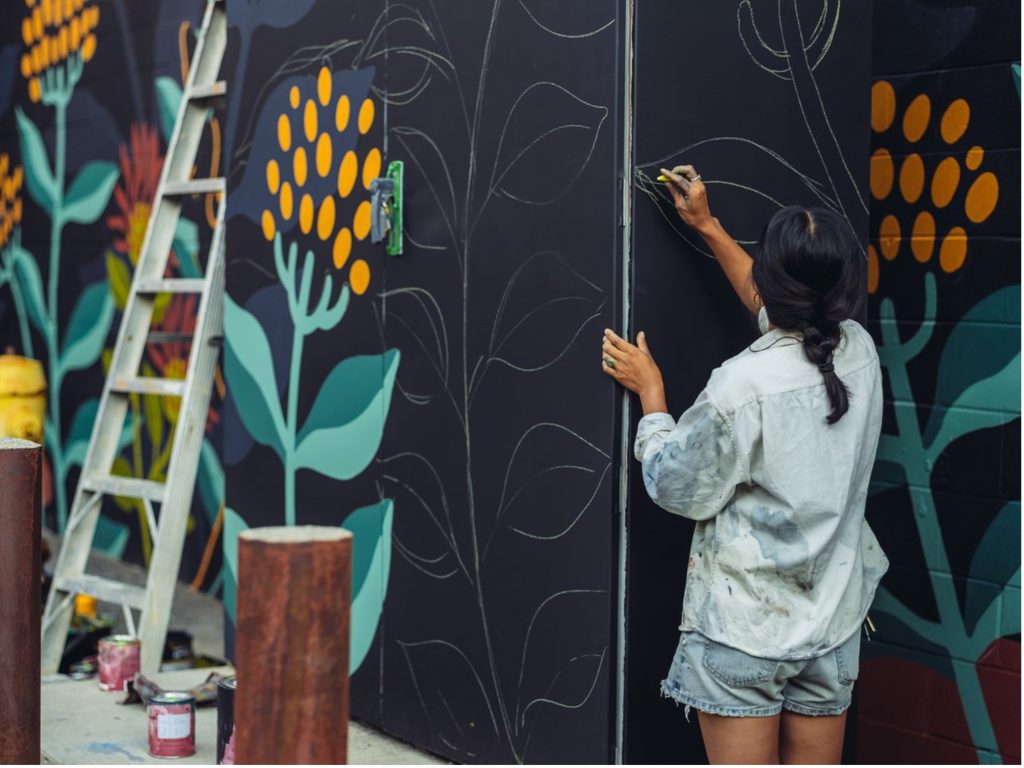Murals and other public art installations can be an exciting, effective way to transform the aesthetics of a property — and, oftentimes, the character of an entire community. Whether it’s for a business district looking to attract customers, a municipality creating a point of interest for visitors, or neighbors venerating a beloved member of their community, murals offer a unique opportunity to simultaneously capture attention, communicate a message and serve as a cultural beacon.
As enjoyable as murals are meant to be for the viewer, lurking behind the scenes is a complex legal framework that governs the ownership, production, maintenance, and protection of murals as one-of-a-kind pieces of art and as investments in the property. The best way to protect both the muralist creating the art and the property owner commissioning it is to discuss the terms of engagement at the start and enter into a written agreement memorializing the parties’ understanding before the work begins. Having an experienced attorney draft the contract couldn’t hurt either.
So, what should a contract between a muralist and a property owner say? Here are a few of the questions to discuss and seek answers to.
Who Owns the Copyright to a Mural?
Copyright, in its most elementary form, means “right to make copies,” so understanding who will own the copyright to the image embodied in the mural is critical to the commissioning process. Hiring a muralist to paint an image on the outside of a building doesn’t automatically grant the property owner the right to replicate that image on T-shirts, posters, advertisements, or other commercial products. The “right to copy” that image is owned by the creator of the image unless the creator transfers that right in writing to the property owner. The owner of the copyright decides which permissions, if any, to grant to others, and for how long, in the form of a license.
After determining which party will own the copyright to the mural image, it’s always a good idea (though not required) to register the artwork with the U.S. Copyright Office and include a copyright notice on the mural itself — typically the copyright symbol (©), followed by the owner’s name and year of creation. Registration with the Copyright Office grants certain benefits to the copyright holder in cases of infringement, including access to federal courts, statutory damages, and recovery of attorney’s fees. The copyright registration fee is generally worth the price of admission.

Photo courtesy of South Agency for iStockphoto
What Licenses Are Needed for a Mural?
If the contract commissioning the mural states that the artist will create and own the copyright to the image, then the property owner should seek a license from the creator to replicate the image however they intend it to be used. The scope of a license can be broadly or narrowly defined, so long as the permissions granted are clear. For example, if a restaurant owner commissions a mural and wants to replicate it on their website, menus and staff uniforms, the restaurant must negotiate a license for those uses in the contract. A licensing agreement can also explicitly deny certain permissions, such as restricting the property owner from using the image for political causes or campaigns. Failure to clearly state and abide by a license’s scope of use can give rise to costly breach of contract claims and copyright infringement, so it’s important for both the muralist and property owner to determine authorized and unauthorized uses during the contract negotiation phase.
In a different scenario, if the contract for the mural states that the property owner will own the copyright to the image, then the artist may want to consider negotiating a limited license for themselves. As an artist’s work history forms their professional résumé, having permission from the copyright holder to showcase the commissioned work online and in the artist’s marketing materials can prove to be a valuable proposition. A license is especially important for the artist when the mural incorporates another business’s trademark.
Additionally, if the mural contains any references borrowed from other creators, such as images, styles, characters, names, or logos belonging to someone else, then whoever furnishes that reference must determine if a license is necessary to use it. Consider, for example, a mural replicating a photograph of a real-life person. In that case, two licenses may be required: one from the person whose likeness appears in the image and one from the person who owns the copyright to the photo. Some rights holders choose to be more aggressive than others when it comes to policing the use of their copyrights and trademarks, so copying or incorporating others’ works without their permission can be a costly risk for both the artist and the property owner. The contract commissioning the mural should state who is responsible for acquiring and paying for third-party licenses, if any are needed.
How Are Muralists Compensated for Their Work?
A contract between a muralist and a property owner should consider not only the overall fee for services, but also the timeline for payment of the fee. Oftentimes the fee will be paid in installments as certain benchmarks are met. For example, a property owner might agree in the contract to pay the artist 25% of the negotiated fee upfront to begin the design work, 25% after the design is approved, 25% after the image is outlined on the building, and 25% upon completion of the mural. Sometimes the fee schedule is simply half up front and half at the end. Whatever the payment provisions are, they should be clear enough for both parties to follow and enforce as the mural gets underway.

Photo courtesy of Fotografia Inc. for istockphoto
Who Maintains the Mural Over Time?
A contract commissioning a mural should state exactly how long the property owner is required to keep, protect and maintain the mural. After all, at some point, the property owner may want to repair it, paint over it or replace it with something new, so the duration or “term” of the maintenance period should be part of the negotiation.
Setting aside natural wear and tear, especially to outdoor murals, a property owner is expected to keep the mural intact for the duration of the term and actively protect it from avoidable destruction. In 1990, Congress passed the Visual Artists Rights Act (“VARA”), a law amending the copyright code, to help visual artists better protect themselves against the unauthorized modification, distortion, or mutilation of their works. In practice, VARA serves as an incentive for property owners to negotiate their own terms regarding the protection and maintenance of the mural in their contract with the artist.
Determining a mural maintenance system requires careful consideration in the contract. A muralist may have an interest in preserving the integrity of their art by requiring the exclusive right to restore it themselves (think images of the infamous botched restoration of the Spanish Ecce Homo Jesus fresco). Meanwhile, the property owner has an interest in protecting their investment in the mural, which may include regular touch-ups from the original artist. At the same time, an artist cannot be expected to tend to every mural they’ve ever created, indefinitely. Whether the artist commits to maintenance for the next few years, reserves the right of first refusal to service the mural or allocates all maintenance rights to the property owner, the most important thing is that the parties agree on a plan to preserve the mural during the term.
The above questions represent a small sample of the many questions a contract commissioning a mural should cover. Every contract is unique and informed by the specific needs, past experiences, and professional counsel of each party.
When executed well, a mural can turn a blighted eyesore into a shining crown jewel overnight and inspire a domino effect that transforms the neighborhood around it, too. That’s the beauty and power of art. With a bit of advanced planning, public art and mural installations can remain a viable, enjoyable experience for everyone — the artist, the property owner, and the community.
_____________________________
Beth Moore is of counsel in Arnall Golden Gregory LLP’s Atlanta office and co-chair of the Entertainment & Sports industry team. She can be contacted at beth.moore@agg.com.









NO COMMENT